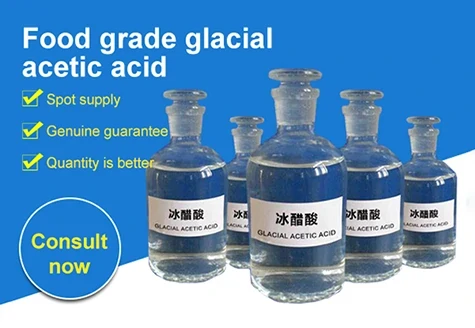
12 月 . 03, 2024 17:46 Back to list
glacial acetic acid solid
Glacial Acetic Acid Properties, Uses, and Safety Considerations
Glacial acetic acid, also known as ethanoic acid, is a colorless liquid with a characteristic pungent smell. It is a pure, anhydrous form of acetic acid, meaning it contains no water. The term glacial originates from its tendency to solidify at lower temperatures, forming ice-like crystals. This unique property and its versatility make glacial acetic acid a significant chemical in various industries.
Properties of Glacial Acetic Acid
Glacial acetic acid has a molecular formula of C₂H₄O₂ and a molecular weight of 60.05 g/mol. At room temperature, it is a viscous liquid that freezes at about 16.6 degrees Celsius (61.88 degrees Fahrenheit). The melting point is slightly above this temperature, leading to its solid state under cold conditions, which resembles ice and can interfere with other substances. It has a boiling point of 118.1 degrees Celsius (244.58 degrees Fahrenheit), making it a stable compound under most conditions.
In terms of chemical properties, glacial acetic acid is classified as a weak acid because it only partially dissociates in water to release hydrogen ions. This property allows it to act as a proton donor in various chemical reactions, which is fundamental to its role in organic synthesis and industrial applications.
Uses of Glacial Acetic Acid
Glacial acetic acid serves numerous functions across various sectors. In the food industry, it is commonly utilized as a food preservative and flavoring agent, typically in the form of vinegar. However, the concentration of acetic acid in glacial acetic acid is much higher than in vinegar, making it unsuitable for direct consumption.
glacial acetic acid solid

One of the primary applications of glacial acetic acid is in the production of synthetic fibers, like acetate. It is vital in the manufacturing of plastics, as it is used to produce compounds such as cellulose acetate, which is used in photography films and eyeglass frames. Additionally, it acts as an essential precursor in the synthesis of various chemicals, including acetic anhydride, which is subsequently used in the production of a wide range of pharmaceuticals and agrochemicals.
Another notable use of glacial acetic acid lies in its role as a solvent in chemical reactions and processes. It dissolves a variety of organic compounds, making it an important solvent in laboratories and industrial settings.
Safety Considerations
While glacial acetic acid is highly useful, safety is paramount in its handling and storage due to its corrosive nature. It can cause severe irritation to the skin and eyes, and its vapors can irritate the respiratory system. Therefore, personal protective equipment (PPE), such as gloves, goggles, and face masks, should be worn when handling glacial acetic acid.
In addition, it is essential to store glacial acetic acid in a cool, well-ventilated area, away from incompatible substances such as strong oxidizers, which can lead to hazardous reactions. Proper disposal methods must be adhered to, following local regulations to mitigate environmental risks.
Conclusion
Glacial acetic acid is a vital compound with a wide array of applications spanning from industrial manufacturing to food production. Its unique physical and chemical properties render it indispensable in various chemical processes. However, due to its corrosive nature, safety precautions are necessary to minimize risks associated with its handling. Understanding both its benefits and the necessary safety measures ensures that glacial acetic acid can be effectively and safely utilized across different domains. As the demand for this invaluable chemical continues to grow, informed practices regarding its use will become increasingly important.
